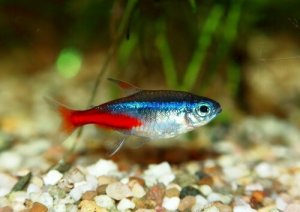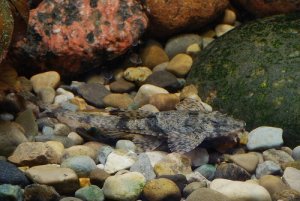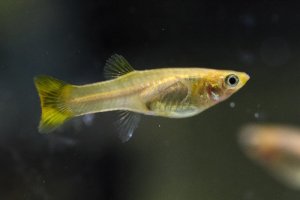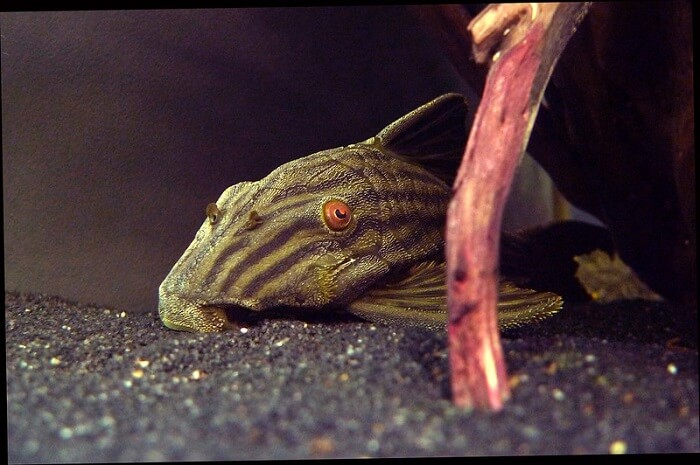
Royal Plecos are incredible, exceptional freshwater fish with prominent colors that bring a pleasant aesthetic and practical element to your tank. They are essentially bottom feeders that thrive on algae and driftwood.
Plecos are moderately easy to keep with a good understanding of the species, though they are close to impossible to breed.
The Royal Pleco can be an essential species in your tank and will get along with almost all other fish species, except its kin, making it perfect for the right type of communal tank. So let’s dive in and find out more about the sizable and remarkable Royal Pleco.
Royal Pleco Breed Overview
| Origin | Venezuela and Brazil, in the Orinoco and Amazon Basins |
| Lifespan | 10 – 14 years |
| Size | Depending on color variant between 16-18 inches (40.6 – 45.7 cm) and 24 Inches (61cm) |
| Colors | Brown, black, and grey with stripes or spots |
| Water Type | Freshwater |
| Tank Size | 120m- 125 gallons minimum |
| Temperament | Placid, nocturnal, territorial towards the same species |
| Water Temperature | 22 -30 °C (71.6-86°F) |
| Water pH | 5 – 7.5 Soft water |
| Difficulty Level | Easy to keep for beginners, hard to breed |
Species Summary
The Royal Pleco, “Panaque nigrolineatus”, often also referred to as the Royal Panaque is an armored Catfish species that is very popular among freshwater fish hobbyists and aquarists.
It is native to Brazil and Venezuela, occurring in the Orinoco and Amazon basins, and is a more substantial-sized catfish species.
A few Interesting facts about the Royal Pleco:
- The scientific name “Panaque” means “fish” in Venezuelan, and “Nigrolineatus” consists of two words, “Nigro” meaning Black, and “Lineatus”, referring to the lines on the Royal Pleco
- It is similarly one of the very few fish species that consumes and digests wood, and it is a complete herbivore.
- The Royal Pleco can reach sizes of up to 61 cm (24 Inches) in perfect conditions, though this is quite rare.
Color Variations
As you will notice the Royal Pleco does not have scales, but rather a hard armor covering its body, consisting of thick plates of skin. The belly is not encased in armor and has a soft skin texture.
Ideally, the Royal Pleco will be a gray/green color with thick blue/black stripes that are darker and well-set. They have fins with gold or cream edges, and their eyes are dull red.
Male And Female Differences
Unfortunately, it is quite difficult to differentiate between male and female Royal Plecos, and they may need to be mature before sexing can be done. The male Royal Pleco will have a genital papilla that is small and pointed, while the females will be rounder and blunt.
Referencing social groups of individuals that keep Royal Plecos, it is said that they only mature and grow to a larger size between 3-5 years. It has been noted that males have a broader head, and females have a rounder tummy, though it remains difficult to tell.
Royal Pleco Subspecies
The line of color variations and sub-species in the Royal Pleco family is rather intricate, so I will only be citing it briefly. Firstly when you are searching for a pet Royal Pleco you will come across the letter “L” usually with a number after it, and sometimes a number and smaller letters “a,b, or c”.
The “L” refers to the large catfish family “Loricariidae” which is the very large catfish family that the Royal Plecos belongs to, while the number indicates the color variation and geographical habitat of the Pleco.
You will notice that the original Royal Pleco is referred to as L190, (Panaque nigrolineatus) being native to the Rio Orinoco in Columbia and Venezuela.
- The Royal Pleco consists of the original L190, and there is a White Tail variation of the L191.
- The Platinum Royal Pleco is similar to the L190, known as the L27A, from Brazil and the Rio Xingu area.
- The Gold Thunder Pleco is known as the L27B, and the Gold Line or Thunder Line of Plecos L27C comes from Rio Tapajos in Brazil.
- The L330 is the Spotted or Watermelon Royal Pleco from Columbia.
- The L418 is the Peruvian Green Royal Pleco or Shampupa Pleco from Peru.
- The L90 is the Papa Royal Pleco, also from Peru.
- The L203 is the Peruvian Black Royal Pleco, the largest of the Royal Pleco family, around 61cm (24 inches), also referred to as Volkswagen Pleco because of its massive size.
Royal Pleco Size And Lifespan
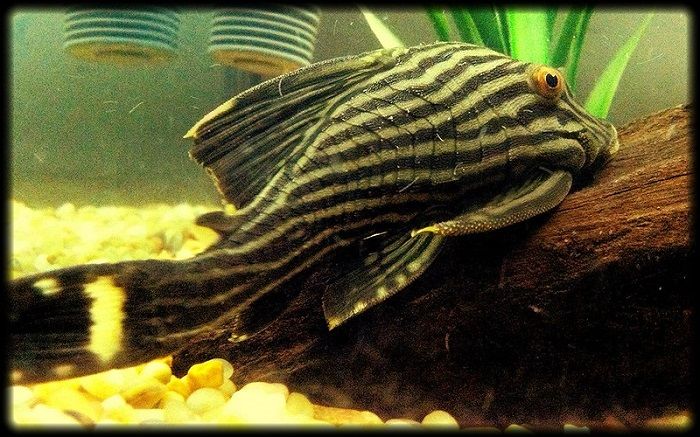
As you noted from the different sub-species of Royal Plecos, some varieties can grow extremely large, however, this article concentrates mostly on the original Royal Pleco L190 species and its requirements.
The L190 Pleco is 16- 18 inches (40.6 – 45.7 cm) in size when fully grown. Though you will notice it stays relatively small the first few years, and only matures between 3-5 years, reaching a lifespan of around 10 years under good conditions.
Temperament And Behavior
Temperament and behavior in the Royal Pleco are much similar to any Panaque species. They are peaceful, and nocturnal bottom dwellers that are ideal in community tanks, however, do not get along well with their species, and can become territorial.
Royal Plecos are large Catfish that need plenty of space, and they are very shy, so you may not see much of them around. In terms of behavior, Panaque is peaceful, passive, and nocturnal bottom-dwellers which makes good residents in community tanks.
General Care
The Royal Pleco, similar to other Panaque species, requires the same care in captivity. They are herbivores with a diet of mostly vegetables, though an interesting fact, they are known as xylophagous, which means that they need Driftwood to graze on to promote good digestion. Some Pleco species require meat-based foods, though the Royal Pleco is not one of them.
The Royal Pleco is a large fish that will produce an enormous amount of waste, thus you will need a high-capacity tank, with a very strong filter. Other than that they are quite easy to care for, and make excellent companions for most other fish species.
Aquarium Set-Up
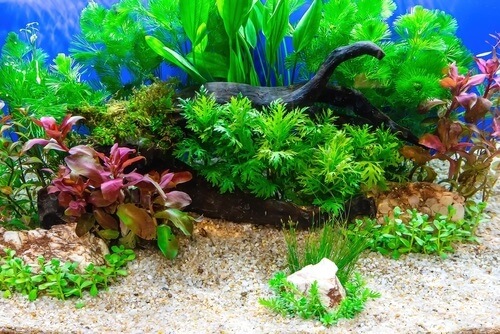
Two important factors when creating an aquarium for a Royal Pleco are that your small Pleco will grow quite large eventually, and Plecos are well-known for generating much waste, which in turn contributes to most of their health conditions if ammonia and nitrate levels are exceeded. Thus, your Pleco will need a large and clean aquarium, however, you can get away with an easy setup of only some substrate and the most vital Driftwood.
- Tank Size – Your Pleco may be small when you first get it, though they grow rather large, thus you need to prepare yourself for at least a 120 – 125 gallon tank, preferably bigger. Keep in mind your fully grown Royal Pleco, even if not swimming around much, still needs ample space to turn around in the tank.
- Water Conditions – The Royal Pleco prefers softer and more acidic water, though they are extremely tolerant to most water conditions and hardness. A pH of around 6.5- 7.5 is ideal, with temperatures of between 22 -30 °C (71.6-86°F).
- Filtration – As said Plecos produce much waste and you will need a high-flow filter with efficient power. It may be possible that additional powerheads are needed for your filter to cope with the size of the tank, and the amount of waste produced.
- Light – You can easily keep your Pleco tank in a low-light area of your home with indirect sunlight. Sunlight, or artificial light is mostly needed for plant growth, though it is needed by your Pleco.
- Heat – Plecos are Tropical fish that are used to higher temperature climates, and will need a heater. A 300W heater is the least and usually suitable for a 55 Gallon tank.
Decorating Your Tank
Please Note: your primary concern when creating an aquarium for a Royal Pleco is DRIFTWOOD!
Plecos spend most of their time on or under driftwood, and they need to feed on driftwood to survive.
- Substrate – Royal Plecos are bottom dwellers, with soft tummies, and for this reason, soft sand or fine gravel is the perfect substrate. They will filter through the substrate to find food. You do not ideally need substrate, as a few rocks are equally ideal, but Plecos enjoy a substrate much more.
- Ornaments and Toys – Any toys, plants, or décor in your tank may be for other fish species kept as tank companions. Though, for the Royal Pleco only a few rocks and driftwood are needed.
- Live Plants – Royal Plecos are herbivores and they tend to destroy live plants in their tanks, and even artificial plants. I would not encourage any plants in a Pleco tank. Still, if you prefer plants you can opt for these species:
- Amazon swords.
- Java Ferns.
- Floating Amazon Frogbit.
- Java Moss.
- Driftwood – Driftwood in your Pleco tank is not only a decoration but an essential requirement for your Royal Pleco. Driftwood contains fiber and nutrients, as well as small microorganisms and algae that Plecos need to feed on. The Driftwood provides a hiding and resting spot and promotes the growth of beneficial bacteria that will help to break down waste in your tank. I recommend purchasing cleaned driftwood from a trusted source or pet store, rather than trying to obtain it yourself, as some woods may be toxic or dirty. Choose driftwood without dangerous sharp edges and that has a smooth texture. You can select from the following driftwood types:
- Malaysian Blackwood
- Spider driftwood
- Mopani driftwood
- Cholla driftwood
- Saba Wood
Introducing And Choosing Your Royal Pleco
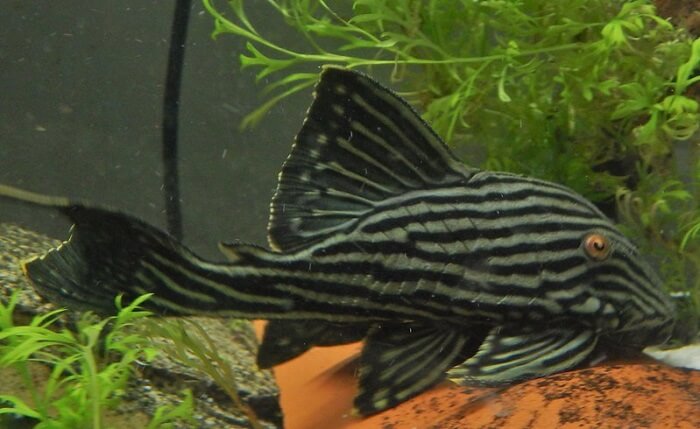
When you finally have your tank decorated, and well cycled, obtaining the best water conditions, and correct parameters, it’s time to choose your Royal Pleco. Essentially we will be choosing the L190 striped Royal Pleco, though there are other color variations similar in size.
Choosing A Pleco
You may need to do some research on breeders, and specialist pet stores, especially if you are considering other Pleco subspecies, though the original Royal Pleco will be easy enough to find.
- Furthermore, a healthy Royal Pleco will have the following:
- A round tummy, with no hollow areas
- Clear red eyes, no cloudy spots or white eyes
- No growths or injuries on the body
- No white spots or discoloration on the fins or the body
- They will have a healthy appetite
How To Place A Fish In A Tank
As with most fish, you will need to acclimate your Pleco first before placing it in the new tank. You can float the fish in its bag on the surface of the water for 20 to 30 minutes, whereafter you can replace around a cup of water from the bag with water from the tank, at 10-minute intervals for another 30 minutes. Now you may place your Pleco in its new home!
Suitable Tank Mates For Royal Plecos
You may have noticed that Plecos, in general, are ideally suitable tank mates for most other fish species, and are chosen mostly for this reason. However, the other way around, Plecos are docile and bottom-dwelling nocturnal fish, that will not bother other tank mates. Unfortunately, Plecos can become territorial towards their species.
Then again Plecos do not do well in heavily planted or lit tanks, and you will need to consider their water parameter requirements with regards to other species of fish. Species such as Tetras, Characins (Abramites, Anostomus, Chilodus) Cichlids, and some predatory fish species are ideal.
Feeding Royal Plecos
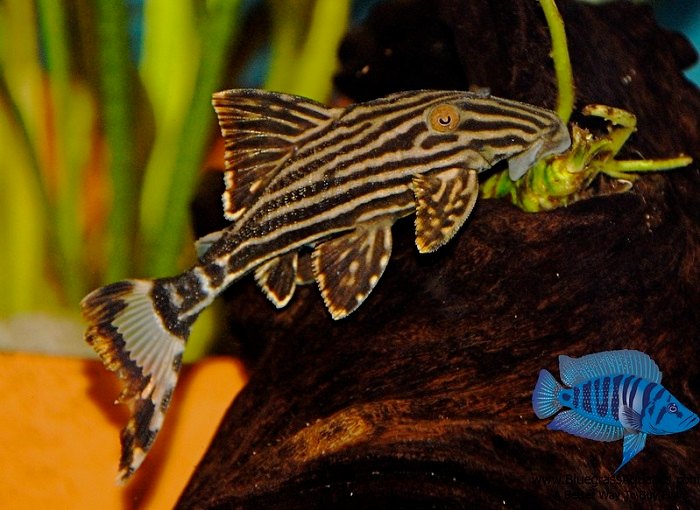
The Royal Pleco is xylophagous, which means it feeds almost primarily on wood, such as Driftwood. They are herbivores and need a balanced diet of plant matter, algae, and permanently available driftwood. You can follow these tips to feed our Royal Pleco:
- Purchase safe driftwood and keep it in your tank for a source of fiber and nutrients.
- Supplement the algae in the tank with algae wafers
- Feed Fruits and vegetables that are fresh and sliced into very small pieces suitable for the size of your Pleco. Broccoli, shelled peas, lima beans, kale, celery, melons, papaya, and cantaloupe are ideal. Avoid acidic fruits though
- Young Plecos will only need an algae wafer per day, a mature adult will need more plant and fruit matter
- Do not overfeed your Pleco, and remove all excess food
- One algae wafer should be fed daily
- Feed fruits and vegetables only twice a week
Tank Maintenance
Royal Plecos, as said, do create a substantial amount of waste and thus regular maintenance and cleaning will be needed. As they generally feed off algae in your tank, only excessive algae should be cleaned. Ensure that you remove all visible excessive waste and dead plant matter.
A weekly water change is vital and can be done by following these steps:
- Remove 25% of the water from your tank using a siphoning hose from the bottom of the tank.
- In a separate container prepare water that is the right temperature, and add your water conditioner
- Test the water conditions with a testing kit, and measure the temperature with your thermometer
- Now you can place the clean water in the tank
Common Pests And Diseases In Plecos
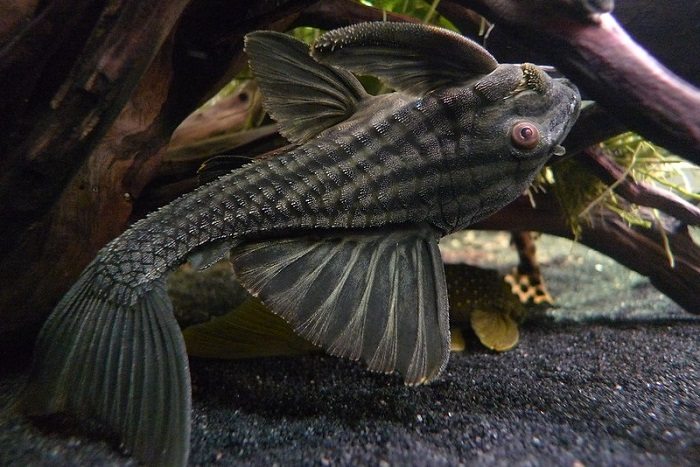
Caring for a Plecostomus, in general, is quite easy, and they have a long life span and rarely get ill. They need clean water and ample space to stay healthy and content. However, there are a few common freshwater fish health issues that may affect them:
- Ich
A protozoan parasite that causes tiny white spots on your fish, usually introduced by new plants or fish in the tank, and by poor water conditions. Quarantine of your Pleco is needed in clean water, and medication can be obtained from a pet store.
- Dropsy
Dropsy is a bacterial infection that causes bloating and discoloration in your Pleco. It can be treated by quarantining your fish and using aquarium salts, along with antibiotics. Sometimes, Plecos tend to overeat which may seem like Dropsy, however, it’s ideally only indigestion.
- Fin Rot
Fin rot is a bacterial infection that causes a ragged appearance and discoloration of the fins, and eventually the body of your fish. It is caused by poor water conditions, and usually physical damage that has become infected. Fin rot can be treated by placing your fish in a separate tank with clean water, and using antibiotics.
- Fish Fungus
Fungal growths may cause gray or white patches on your Plecos body, resembling cotton balls. It is a secondary infection, usually because of a skin condition or injury. The fungus grows in low water temperatures and poor water conditions. Thus, you can place your fish in a separate tank with higher temperatures and clean water and ask a specialist for appropriate medication.
- Pop-Eye
Pop Eye or protruding eyes in Plecos is quite common and caused by a bacterial infection in their eyes. Providing vitamin supplements foods, and doing more regular water changes can help with the Condition.
- Hole in The Head
If you notice small indentations or holes in your Plecos head, it is caused by head and lateral erosion from poor water quality, and overexposure to activated carbon. By improving water conditions and nutrition you may prevent and treat the condition.
- Cloudy Eye
Another common issue in Plecos is Cloudy Eyes which cause a white slime covering to cover the eyes. It affects their vision and is usually related to poor water quality. Improving water quality should clear up the condition.
Disease Prevention
As you may have noticed from most of the health issues with Plecos, their causes are mainly poor water conditions and poor nutrition. Plecos essentially need clean water, and because they produce so much waste ammonia and nitrate levels in their tank can quickly spike, causing illness.
Improper or overfeeding can lead them to become bloated, and malnutrition can weaken their immune system or cause dents in their tummies. So, thorough care needs to be taken regarding Feeding and Water conditions, with plecos.
Breeding Royal Plecos
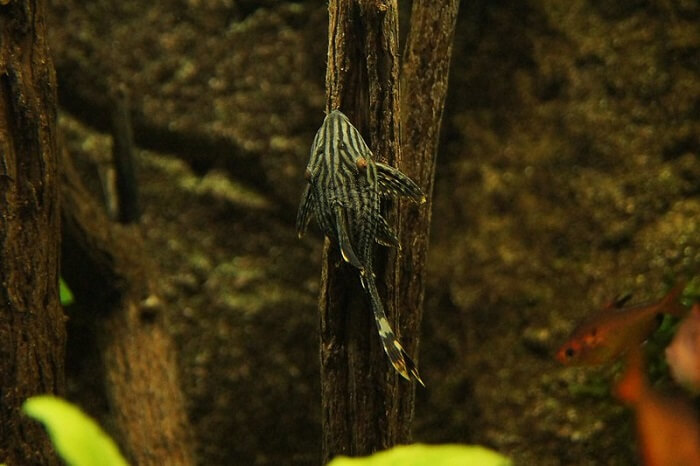
Generally, it is not advised to breed Royal Plecos, unless you are a professional breeder that has the resources and knowledge to pull it off. Royal Plecos are extremely difficult to breed.
Did you know that they are quite sensitive to harvesting for the pet trade even in the wild, as it takes them over 14 years to double their population again?
Royal Plecos take between 3-5 years before they are mature, and they are difficult to determine the sex of. To breed them you will need to mimic seasonal changes that resemble the climates in their natural habitat. Also, keep in mind that Plecos in general do not get along with each other.
Nonetheless, to oblige the subject, this is what you will need to achieve, to possibly, though rarely breed Royal Pleco in captivity:
- You will need a well-bonded pair that have been friends from a young age.
- Heavy rains in their natural habitat will usually precede the breeding season, thus you need to mimic this by lowering the water temperature and increasing water hardness levels.
- Feed your bonded pair high-quality foods, especially Vinewood which is critical to induce breeding.
- If all goes well, your female will lay eggs on a selected substrate, and arrange them to create a pile for the male to fertilize.
Mainly you want to prevent fungus growing on your Pleco eggs so it is advisable to keep the tank well circulated or oxygenated or to move them to a smaller tank to encourage this. Pleco males make good fathers and will take care of the eggs if needed. Pleco eggs hatch within a week or so. You will notice the fry will only pop out the head and fins for swimming, with the belly attached to the yolk sack for feeding, until they become independent.
Final Thoughts
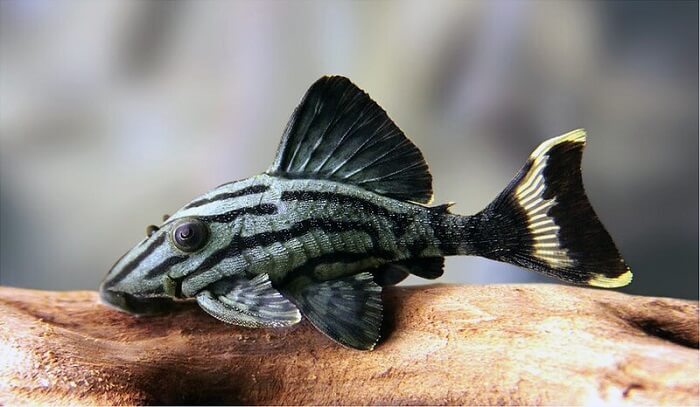
Even though the Royal Pleco is almost impossible to breed, it is still ideal and very easy to keep, under the right conditions. You will have an impressive nocturnal fish to keep on its own for quite some years, or to add to your community tank as a companion, which will ideally also clear your tank of algae.


